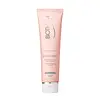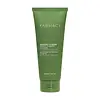BIOTHERM Biosource Softening Foaming Cleanser Dry Skin Versus Farmacy Green Clean Whipped Foaming Cleanser
What's inside
What's inside
 Key Ingredients
Key Ingredients

 Benefits
Benefits

 Concerns
Concerns

 Ingredients Side-by-side
Ingredients Side-by-side

Water
Skin ConditioningGlycerin
HumectantSodium Cocoyl Glycinate
CleansingMontmorillonite
AbsorbentMyristic Acid
CleansingButylene Glycol
HumectantArgilla
AbrasivePalmitic Acid
EmollientGlycol Stearate
EmollientLauric Acid
CleansingStearic Acid
CleansingPotassium Hydroxide
BufferingCI 77891
Cosmetic ColorantSodium Chloride
MaskingSodium Hydroxide
BufferingKaolin
AbrasiveMagnesium Gluconate
Skin ConditioningVitreoscilla Ferment
Skin ConditioningTrisodium Ethylenediamine Disuccinate
Salicylic Acid
MaskingPhenoxyethanol
PreservativeCI 14700
Cosmetic ColorantLinalool
PerfumingGeraniol
PerfumingCitronellol
PerfumingBenzyl Alcohol
PerfumingBenzyl Salicylate
PerfumingParfum
MaskingWater, Glycerin, Sodium Cocoyl Glycinate, Montmorillonite, Myristic Acid, Butylene Glycol, Argilla, Palmitic Acid, Glycol Stearate, Lauric Acid, Stearic Acid, Potassium Hydroxide, CI 77891, Sodium Chloride, Sodium Hydroxide, Kaolin, Magnesium Gluconate, Vitreoscilla Ferment, Trisodium Ethylenediamine Disuccinate, Salicylic Acid, Phenoxyethanol, CI 14700, Linalool, Geraniol, Citronellol, Benzyl Alcohol, Benzyl Salicylate, Parfum
Water
Skin ConditioningGlycerin
HumectantSodium Lauroyl Isethionate
CleansingSodium Cocoyl Glycinate
CleansingDecyl Glucoside
CleansingMagnesium Aluminum Silicate
AbsorbentSodium Lauroyl Methyl Isethionate
CleansingCoconut Acid
CleansingSodium Lauroamphoacetate
CleansingMyristic Acid
CleansingSodium Lauroyl Lactylate
EmulsifyingMoringa Oleifera Leaf Water
Skin ConditioningSodium PCA
HumectantKaolin
AbrasiveLactobacillus/Papaya Fruit Ferment Extract
AbrasiveMoringa Oleifera Seed Extract
Skin ConditioningMontmorillonite
AbsorbentCitrus Limon Fruit Extract
MaskingQuillaja Saponaria Wood Extract
Skin ConditioningLauric Acid
CleansingCocamide Mipa
EmulsifyingSodium Isethionate
CleansingXanthan Gum
EmulsifyingSodium Polyacryloyldimethyl Taurate
Emulsion StabilisingSodium Benzoate
MaskingPalmitic Acid
EmollientLactic Acid
BufferingIllite
Abrasive3-Hexenol
MaskingBeta-Caryophyllene
MaskingCanarium Luzonicum Gum Nonvolatiles
MaskingCitronellal
MaskingCitrus Aurantifolia Fruit Extract
Skin ConditioningCitrus Aurantium Dulcis Fruit Extract
MaskingEugenol
PerfumingHydroxyacetophenone
AntioxidantHexenyl Acetate
MaskingLinalool
PerfumingLinalyl Acetate
MaskingTriethyl Citrate
MaskingZingiber Officinale Extract
Skin ConditioningCapric Acid
CleansingQuartz
AbrasiveSaponaria Officinalis Leaf/Root Extract
Skin ConditioningLeuconostoc/Radish Root Ferment Filtrate
AntimicrobialGluconolactone
Skin ConditioningMaltodextrin
AbsorbentCI 19140
Cosmetic ColorantCI 42090
Cosmetic ColorantLimonene
PerfumingWater, Glycerin, Sodium Lauroyl Isethionate, Sodium Cocoyl Glycinate, Decyl Glucoside, Magnesium Aluminum Silicate, Sodium Lauroyl Methyl Isethionate, Coconut Acid, Sodium Lauroamphoacetate, Myristic Acid, Sodium Lauroyl Lactylate, Moringa Oleifera Leaf Water, Sodium PCA, Kaolin, Lactobacillus/Papaya Fruit Ferment Extract, Moringa Oleifera Seed Extract, Montmorillonite, Citrus Limon Fruit Extract, Quillaja Saponaria Wood Extract, Lauric Acid, Cocamide Mipa, Sodium Isethionate, Xanthan Gum, Sodium Polyacryloyldimethyl Taurate, Sodium Benzoate, Palmitic Acid, Lactic Acid, Illite, 3-Hexenol, Beta-Caryophyllene, Canarium Luzonicum Gum Nonvolatiles, Citronellal, Citrus Aurantifolia Fruit Extract, Citrus Aurantium Dulcis Fruit Extract, Eugenol, Hydroxyacetophenone, Hexenyl Acetate, Linalool, Linalyl Acetate, Triethyl Citrate, Zingiber Officinale Extract, Capric Acid, Quartz, Saponaria Officinalis Leaf/Root Extract, Leuconostoc/Radish Root Ferment Filtrate, Gluconolactone, Maltodextrin, CI 19140, CI 42090, Limonene
Ingredients Explained
These ingredients are found in both products.
Ingredients higher up in an ingredient list are typically present in a larger amount.
Glycerin is already naturally found in your skin. It helps moisturize and protect your skin.
A study from 2016 found glycerin to be more effective as a humectant than AHAs and hyaluronic acid.
As a humectant, it helps the skin stay hydrated by pulling moisture to your skin. The low molecular weight of glycerin allows it to pull moisture into the deeper layers of your skin.
Hydrated skin improves your skin barrier; Your skin barrier helps protect against irritants and bacteria.
Glycerin has also been found to have antimicrobial and antiviral properties. Due to these properties, glycerin is often used in wound and burn treatments.
In cosmetics, glycerin is usually derived from plants such as soybean or palm. However, it can also be sourced from animals, such as tallow or animal fat.
This ingredient is organic, colorless, odorless, and non-toxic.
Glycerin is the name for this ingredient in American English. British English uses Glycerol/Glycerine.
Learn more about GlycerinKaolin is a clay. It is used for oil control and to help minimize pores. Like other clays, kaolin has the ability to absorb excess sebum or oil. This can help clean out pores and mattify the skin.
Some types of kaolin may have exfoliating properties. When water is added to kaolin, it becomes a paste with small abrasive particles.
Most kaolin is a white color, but may be pink/orange/red depending on where it comes from.
The name 'kaolin' comes from a Chinese village named 'Gaoling'. Kaolin clay comes from rocks rich in kaolinite. Kaolinite, the mineral, has a silicate layered structure. Kaolinite is formed from chemical weathering of aluminum siilicate minerals.
Besides skincare, kaolin is commonly used to make glossy paper, in ceramics, toothpaste, and as medicine to soothe stomach issues.
Learn more about KaolinLauric Acid is a fatty acid or lipid. About half of fatty acids in coconut oil is lauric acid.
This ingredient helps hydrate and sooth skin. As a humectant, it helps trap moisture. It also aids in cleaning and enhancing the texture of products.
Lauric acid may not be Malassezia folliculitis, or fungal acne, safe.
Learn more about Lauric AcidLinalool is a fragrance and helps add scent to products. It's derived from common plants such as cinnamon, mint, citrus, and lavender.
Like Limonene, this ingredient oxidizes when exposed to air. Oxidized linalool can cause allergies and skin sensitivity.
This ingredient has a scent that is floral, spicy tropical, and citrus-like.
Learn more about LinaloolMontmorillonite is a clay (aluminomagnesium silicate) with strong absorption properties. It has a similar pH to skin.
This clay is named after Montmorillon in France.
Learn about other types of clay, such as Kaolin, Bentonite, or Fuller's Earth.
Learn more about MontmorilloniteMyristic Acid is a saturated fatty acid. It is naturally found in milk fat. Other sources include palm oil, coconut oil, and butter fat.
Myristic Acid is an emulsifer and cleanser. As an emulsifer, it stabilizes a product by preventing ingredients from separating. Myristic Acid helps clean your skin by acting as a surfactant. It tends to gather oil and dirt on your skin to be easily rinsed away.
One study from 2021 found Myristic Acid to have anti-inflammatory properties.
Learn more about Myristic AcidPalmitic Acid is a fatty acid naturally found in our skin and in many plant and animal sources. In cosmetics, it is usually derived from palm oil. It serves many purposes in skincare, acting as a cleanser, emollient, and emulsifier.
As an emollient, palmitic acid helps soften and smooth the skin by preventing water loss. In cleansers, it helps remove oil and dirt while creating foam.
Its emulsifying properties help stabilize products by keeping water and oil-based ingredients from separating.
This may not be suitable for fungal acne-prone skin, as fatty acids like this can sometimes trigger breakouts in sensitive individuals.
Learn more about Palmitic AcidSodium Cocoyl Glycinate is a cleansing agent. It can be naturally derived or synthetically-created.
As a surfactant, it helps clean your skin by gathering dirt, oil, and other pollutants to be rinsed away more easily.
Water. It's the most common cosmetic ingredient of all. You'll usually see it at the top of ingredient lists, meaning that it makes up the largest part of the product.
So why is it so popular? Water most often acts as a solvent - this means that it helps dissolve other ingredients into the formulation.
You'll also recognize water as that liquid we all need to stay alive. If you see this, drink a glass of water. Stay hydrated!
Learn more about Water